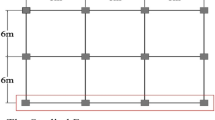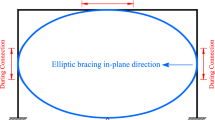Abstract
Fragility functions are determined for braced steel moment frames (SMFs) with plans such as square-, T-, L-, U-, trapezoidal-, and semicircular-shaped, subjected to blast. The frames are designed for gravity and seismic loads, but not necessarily for the blast loads. The blast load is computed for a wide range of scenarios involving different parameters, viz. charge weight, standoff distance, and blast location relative to plan of the structure followed by nonlinear dynamic analysis of the frames. The members failing in rotation lead to partial collapse due to plastic mechanism formation. The probabilities of partial collapse of the SMFs, with and without bracing system, due to the blast loading are computed to plot fragility curves. The charge weight and standoff distance are taken as Gaussian random input variables. The extent of propagation of the uncertainties in the input parameters onto the response quantities and fragility of the SMFs is assessed by computing Sobol sensitivity indices. The probabilistic analysis is conducted using Monte Carlo simulations. The frames have least failure probability for blasts occurring in front of their corners or convex face. Further, the unbraced frames are observed to have higher fragility as compared to counterpart braced frames for far-off detonations.





















Similar content being viewed by others
References
Alrudaini, T. M. S. (2011). A new mitigation scheme to resist the progressive collapse of reinforced concrete buildings. Doctor of Philosophy Thesis, University of Wollongong, Wollongong, Australia.
ASCE 7-05. (2005). Minimum design loads for buildings and other structures. Reston, VA: American Society of Civil Engineers (ASCE).
ASCE 41-06. (2007). Seismic rehabilitation of existing buildings. Reston, VA: American Society of Civil Engineers (ASCE).
Asprone, D., Jalayer, F., Prota, A., & Manfredi, G. (2010). Proposal of a probabilistic model for multi-hazard risk assessment of structures subjected to blast loads for the limit state of collapse. In 14th world conference on earthquake engineering, Beijing, China.
Bandyopadhyay, M., Banik, A. K., & Datta, T. K. (2015). Progressive collapse of three-dimensional semi-rigid jointed steel frames. Journal of Performance of Constructed Facilities. https://doi.org/10.1061/(ASCE)CF.1943-5509.0000796.
Barakat, M. A., & Hetherington, J. G. (1998). New architectural forms to reduce the effects of blast waves and fragments on structures. In WIT Transactions on the built environment: Structures Under shock and impact (Vol. 32, pp. 53–62). https://www.witpress.com/Secure/elibrary/papers/SU98/SU98005FU.pdf.
Barakat, M. A., & Hetherington, J. G. (1999). Architectural approach to reducing blast effects on structures. Proceedings of the Institution of Civil Engineers: Structures and Buildings, 134(4), 333–343.
Bažant, Z., & Verdure, M. (2007). Mechanics of progressive collapse: Learning from World Trade Center and building demolitions. Journal of Engineering Mechanics, 133, 308–319.
Bilal, N. (2014). Implementation of Sobol’s method of global sensitivity analysis to a compressor simulation model. In 22nd international compressor engineering conference, Purdue, USA (pp. 1–10).
Byfield, M., & Paramasivam, S. (2012). Murrah building collapse: Reassessment of the transfer girder. Journal of Performance of Constructed Facilities, 26(4), 371–376.
CSI (Computers and Structures, Inc.). (2016). SAP2000: Integrated solution for structural analysis and design, version 16. Berkeley, CA: CSI Analysis Reference Manual.
Dat, P. X., & Tan, K. H. (2013). Membrane actions of RC slabs in mitigating progressive collapse of building structures. Engineering Structures, 55, 107–115.
FEMA 356. (2000). Pre-standard and commentary for the seismic rehabilitation of buildings., Risk management series Washington, DC: Federal Emergency Management Agency (FEMA).
Fortner, B. (2004). Symbol of strength. Civil Engineering, 74(10), 36–45.
Gebbeken, N., & Döge, T. (2010). Explosive protection—Architectural design, urban planning and landscape planning. International Journal of Protective Structures, 1(1), 1–21.
Goel, M. D., Matsagar, V. A., Gupta, A. K., & Marburg, S. (2012). An abridged review of blast wave parameters. Defense Science Journal, 62(5), 300–306.
Grierson, D. E., Xu, L., & Liu, Y. (2005). Progressive failure analysis of buildings subjected to abnormal loadings. Computer-Aided Civil and Infrastructure Engineering, 20, 155–177.
GSA. (2013). Alternate path analysis & design guidelines for progressive collapse resistance. Washington, DC: General Services Administration (GSA).
Hamburger, R., & Whittaker, A. (2004). Design of steel structures for blast related progressive collapse resistance. In North American steel construction conference, USA (pp. 41–53).
Khan, S., Saha, S. K., Matsagar, V. A., & Hoffmeister, B. (2017). Fragility of steel frame buildings under blast load. Journal of Performance of Constructed Facilities. https://doi.org/10.1061/(ASCE)CF.1943-5509.0001016.
Kinney, G. F., & Graham, K. J. (1985). Explosive shocks in air. Berlin: Springer.
Liew, R. J. Y. (2007). Survivability of steel frame structures subject to blast and fire. Journal of Constructional Steel Research, 64, 854–886.
Mathworks, Inc. (2013). MATLAB ® version R2013b [Computer software], Natick, MA.
Netherton, M. D., & Stewart, M. G. (2009). Probabilistic modeling of safety and damage blast risks for window glazing. Canadian Journal of Civil Engineering, 36(8), 1321–1331.
Parisi, F. (2015). Blast fragility and performance-based pressure-impulse diagrams of European reinforced concrete columns. Engineering Structures, 103, 285–297.
Sobol, I. M. (1993). Sensitivity analysis for nonlinear mathematical models. Mathematical Modeling and Computational Experiment, 1, 407–414.
Sobol, I. M. (2001). Global sensitivity indices for nonlinear mathematical models and their Monte Carlo. Mathematics and Computers in Simulations, 55, 271–280.
Sudret, B. (2008). Global sensitivity analysis using polynomial chaos expansions. Reliability Engineering and System Safety, 93, 964–979.
Szyniszewski, S., & Krauthammer, T. (2012). Energy flow in progressive collapse of steel framed buildings. Engineering Structures, 42, 142–153.
UFC 3-340-02. (2008). Structures to resist the effects of accidental explosions. Unified Facilities Criteria (UFC), U.S. Army Corps of Engineers, Naval Facilities Engineering Command, Air Force Civil Engineer Support Agency, USA.
Vasilis, K., Solomos, G., & Viaccoz, B. (2013). Calculation of blast loads for application to structural components. LB-NA-26456-EN-N, JRC Technical Reports, Joint Research Centre (JRC), European Union (EU), Italy.
Author information
Authors and Affiliations
Corresponding author
Rights and permissions
About this article
Cite this article
Kumar, A., Matsagar, V. Blast Fragility and Sensitivity Analyses of Steel Moment Frames with Plan Irregularities. Int J Steel Struct 18, 1684–1698 (2018). https://doi.org/10.1007/s13296-018-0077-z
Received:
Accepted:
Published:
Issue Date:
DOI: https://doi.org/10.1007/s13296-018-0077-z




